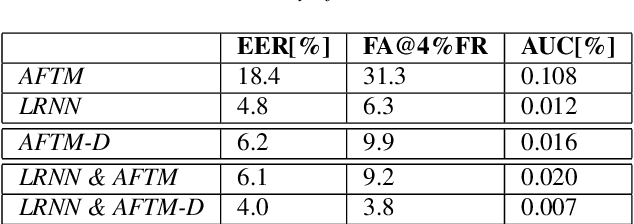Ahmed H. Abdelaziz
Device-Directed Speech Detection for Follow-up Conversations Using Large Language Models
Nov 04, 2024Abstract:Follow-up conversations with virtual assistants (VAs) enable a user to seamlessly interact with a VA without the need to repeatedly invoke it using a keyword (after the first query). Therefore, accurate Device-directed Speech Detection (DDSD) from the follow-up queries is critical for enabling naturalistic user experience. To this end, we explore the notion of Large Language Models (LLMs) and model the first query when making inference about the follow-ups (based on the ASR-decoded text), via prompting of a pretrained LLM, or by adapting a binary classifier on top of the LLM. In doing so, we also exploit the ASR uncertainty when designing the LLM prompts. We show on the real-world dataset of follow-up conversations that this approach yields large gains (20-40% reduction in false alarms at 10% fixed false rejects) due to the joint modeling of the previous speech context and ASR uncertainty, compared to when follow-ups are modeled alone.
Device-Directed Speech Detection: Regularization via Distillation for Weakly-Supervised Models
Mar 30, 2022



Abstract:We address the problem of detecting speech directed to a device that does not contain a specific wake-word. Specifically, we focus on audio coming from a touch-based invocation. Mitigating virtual assistants (VAs) activation due to accidental button presses is critical for user experience. While the majority of approaches to false trigger mitigation (FTM) are designed to detect the presence of a target keyword, inferring user intent in absence of keyword is difficult. This also poses a challenge when creating the training/evaluation data for such systems due to inherent ambiguity in the user's data. To this end, we propose a novel FTM approach that uses weakly-labeled training data obtained with a newly introduced data sampling strategy. While this sampling strategy reduces data annotation efforts, the data labels are noisy as the data are not annotated manually. We use these data to train an acoustics-only model for the FTM task by regularizing its loss function via knowledge distillation from an ASR-based (LatticeRNN) model. This improves the model decisions, resulting in 66% gain in accuracy, as measured by equal-error-rate (EER), over the base acoustics-only model. We also show that the ensemble of the LatticeRNN and acoustic-distilled models brings further accuracy improvement of 20%.
 Add to Chrome
Add to Chrome Add to Firefox
Add to Firefox Add to Edge
Add to Edge